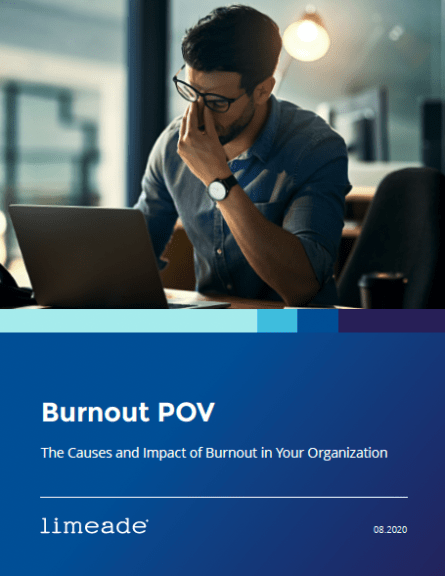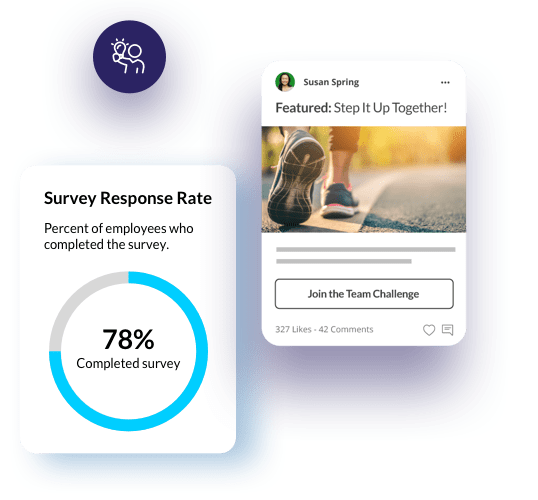Resource
The causes and impact of burnout in your organization

This research article was written by The Limeade Institute — a team of researchers and advisors with deep expertise and advanced degrees in the areas of organizational psychology, psychometrics, data science and other related fields.
Contents
- Summary
- Introduction
- Burnout Defined
- Impact of Burnout
- Drivers of Burnout
- Conclusion
- Recommendations — Burnout Prevention
- Research Download
- References
Summary
The potential for engaged employees to be more susceptible to burnout illustrates the emerging “dark side” of employee engagement. This “dark side” shows up when employee engagement is viewed and sought after in a vacuum — when the pursuit of greater employee engagement fails to maintain well-being and when burnout is only viewed through the lens of what happens at work. Dedicated and engaged employees draw on their available resources to actively approach and tackle the ever-present reality of work and life demands; if these resources are not replaced, however, employees begin to give more and more of themselves without any refueling. This opens the door for these committed employees to suffer the dangerous impact of burnout. When employees experience burnout, both the employees and their organization suffer negative consequences. In this paper, we summarize how burnout has been historically approached in the organizational literature, outline the relationship it holds to employee engagement, and review ways organizations can proactively protect their employees from burnout.
Introduction
With the growing focus on employee engagement as a much-desired worker attribute, discussions of the “dark side” of engagement have emerged (Garrad & Chamorro-Premuzic, 2016). Among these is the notion that engaged, on fire employees are susceptible to burning out (Pines, Aronson, & Kafry, 1981). Although the research and literature on the association between engagement and burnout is mixed, it’s an important question for organizations to consider as they strive to reap the benefits of a highly engaged workforce. In this paper, we’ll discuss what burnout is, how it relates to engagement and why it matters. We will then propose ways in which organizations can continue to support their engaged employees and protect them against burnout.
Burnout Defined
Burnout has been conceptualized primarily in the work domain and is currently understood as an employee’s response to prolonged exposure to stress and work overload (Hakanen & Bakker, 2017). The response to stress and overload is characterized by three dimensions: exhaustion, cynicism and feelings of inefficacy (Maslach & Leiter, 1997). Specifically, exhaustion refers to feeling overextended and depleted of one’s emotional and physical resources. Exhausted employees have very low levels of energy left to exert. Cynicism, on the other hand, is a negative, callous and detached response to work and peers within the organization. This emotional and cognitive detachment can be understood as the employee’s attempt to cope with the stress and work overload. Finally, inefficacy is a sense of reduced personal accomplishment wherein the employee no longer feels as if he/ she is making a difference at work (Maricutoiu, Saulea, & Iancu, 2017). Overall, burnout is regarded as a negative physical, mental and emotional state that does not emerge on its own but rather develops over time as a response to prolonged exposure to stress and overload at work.
Burnout and Engagement
Because the two concepts are strongly correlated, the relationship between burnout and employee engagement has generated debate in the literature (Anthony- McMann, Ellinger, Astakhova, & Halbesleben, 2017; Bakker, van Emmerik, & Euwema, 2006; Maricutoiu et al., 2017; Schaufeli & Salanova, 2011). While burnout is reflected through an employee’s cynicism, feelings of exhaustion and inefficacy, engagement is instead characterized by vigor, dedication and absorption in the work one does (Christian, Garza, & Slaughter, 2011). Engaged employees exhibit energy in their work, burned out employees reflect depletion of energy. Because of these opposing characteristics, engagement was initially understood as the direct opposite of burnout (Maslach & Leiter, 1997; Cole, Walter, Bedeian, & O’Boyle, 2012). This view of burnout implies that disengagement equates to burnout. Scholars have since rejected this premise, arguing that although the two are connected, a disengaged employee does not equate to a burned out employee (Halbesleben, 2010; Kahn, 2010; Schaufeli & Salanova, 2011). While a burned out employee feels the exhaustion from prolonged investment of personal resources, a disengaged employee feels apathetic and may have never cared to invest any resources in the first place.
Over time, the additional research and literature that has emerged further supports the notion that engagement and burnout, though connected, stand as distinct concepts (Marticutoiu et al., 2017; Schaufeli & Salanova, 2014). Both emerge from an initial care for the work one does, as both entail an investment of personal resources into work. Engaged employees draw on their available resources to actively approach and tackle job demands; if these resources are not replaced, however, employees begin to give more and more of themselves without any refueling (Schaufeli, Salanova, González-Roma, & Bakker, 2002). In other words, when employees are engaged, their well-being must be maintained through both individual and organizational effort. If well-being is not maintained, individual resources may drain to the point of burnout.
Well-being — the Missing Link
The potential for engaged employees to be more susceptible to burnout illustrates the emerging “dark side” of employee engagement. This “dark side” shows up when employee engagement is viewed and sought after in a vacuum — when the pursuit of greater employee engagement fails to maintain well-being and when burnout is only viewed through the lens of what happens at work. To this end, the Conservation of Resources (COR) theory is particularly relevant (Halbesleben, Neveu, Paustian-Underdahl, & Westman, 2014; Hobfoll, 1989). COR suggests that individuals have a limited set of personal resources (e.g., time, energy, attention) to draw from and are highly motivated to protect them. With increasing levels of engagement, employees want to contribute more of these resources to their work, likely drawing from other areas of their life to do so (Allen, Herst, Burck, & Sutton, 2000). However, home and life demands are an ever-present reality that require resources of their own (Peeters, Montgomery, Bakker, & Schaufeli, 2005). It makes sense then, that when engaged employees invest their limited resources and there is insufficient or ineffective organizational support for well-being to refuel them, burnout is likely to occur (Scahufeli, Bakker, & Salanova, 2006). Therefore, to ignore the relationship between whole-person well-being and engagement is not only naïve but risky. It’s with this relationship in mind that we approach burnout.
Given the connection that burnout has with engagement, well-being and organizational support, we propose an updated definition of burnout to highlight these components.
Limeade Burnout Definition
Burnout is when people have been highly engaged for a long time, without the personal skills and organizational support to maintain their well-being. Burnout is a harmful individual and organizational virus that targets the most committed employees.
Impact of Burnout
When employees experience burnout, both the employees and their organization suffer negative consequences. For employees, burnout has “spillover” effects into all parts of their lives. For example, feelings of burnout are positively related to work/family conflict (Allen et al., 2000), which researchers theorize occurs as a result of resources (e.g., time, attention) being taken from home to replace the need that is present at work. Burnout also spills over into one’s health, as it is positively related to employee health problems — likely a result of the prolonged exposure to the harmful effects of stress (Schaufeli & Bakker, 2004). Among many other harmful effects, burnout can increase the amount of anxiety, depression, headaches and sleep disturbances that employees experience (Kim, Ji, & Kao, 2011). Burnout therefore has real and dangerous impacts on both psychological and physical employee health.
In addition to harming employees, burnout has several dangerous impacts on organizations. The health problems of burned out employees cost an estimated $125 billon to $190 billion a year in healthcare spending, with high demands at work and work-family conflict among the top contributing factors (Blanding, 2015). Moreover, when employees feel exhausted, with few resources to give to their work, organizational productivity and effectiveness takes a hit (Maslach, Schaufeli, & Leiter, 2001). In addition, the cynicism that develops in burned out employees reduces their levels of job satisfaction and the level of commitment they have to the organization (Maslach et al., 2001). These drained employees demonstrate various forms of job withdrawal — absenteeism, intention to leave the organization, and ultimately, actual turnover (Dreison et al., 2018). Finally, burned out employees have a viral effect on other employees, increasing personal conflicts and task disruptions at work (Maslach et al., 2001). Simply put, burnout is a toxic individual and organizational virus.
Given these symptoms of burnout, identification of a burned out employee often occurs when the exhausted individual either informs his/her manager, begins to withdraw from work or starts missing work entirely. We believe it’s important to identify employees that are at risk for burnout before they reach this point. To determine whether an employee is at risk for burnout, we created the Limeade Burnout Risk Indicator.
Drivers of Burnout
The majority of research on the drivers of burnout have identified several work characteristics that predict burnout. Workload, role conflict, role ambiguity and job demands are just a few examples of the stressors employees experience at work (Maslach et al., 2001). Although stressors are a reality that most workers face, prolonged exposure to these gives rise to burnout. Moreover, lack of fairness, resources, support or feedback at work also lead to increased burnout (Schaufeli & Bakker, 2004). In other words, without the organization or the individual intervening in some way, stress will start to chip away at the well-being of employees. It makes sense, then, that organizational reciprocity of resources also predicts burnout (Schaufeli et al., 2006). If there is a lack of mutual commitment, wherein the organization fails to give resources and support back to the employee, the vigor and energy that an employee is exerting may be quickly depleted and turn to burnout.
In addition to these work factors, employees may suffer burnout as the result of personal factors. For example, burnout symptoms are predicted by the number of negative life events that individuals experience, such as divorce, personal illness or family illness (Dyrbe et al., 2006). Hakanen & Bakker (2017) found that these types of negative life events, combined with job demands, had more of an impact on women than on men, seemingly a result of a greater influence of the double burden of work and home demands (Väänänen et al., 2004). These findings reinforce the notion that to help identify and guard against burnout, organizations must consider the whole-person well-being of employees (i.e., how they are doing both at work and outside of it).
Conclusion
The continued popularity of employee engagement as a desirable outcome for both individuals and organizations has led to the rise of discussions regarding the potential “dark side” it may hold. Specifically, the vigor and dedication that employees show to their organizations and work have led to the fear that these individuals fall prey to employee burnout. Research and literature on the topic has indicated that when their investment in their work is not coupled with a refueling of resources and maintenance of whole-person well-being (which requires both individual skills and organizational support), engaged employees may likely burnout (Schaufeli et al., 2006). In other words, increasing employee engagement should not and cannot be considered without also considering employee well-being. It’s when the two are separated within organizational conversations that “dark sides” such as burnout creep in. Instead of reacting to burnout after it has already taken its course, we encourage organizations and employees to engage in proactive efforts against it. We therefore end with recommendations on how organizations, managers and individuals can reframe their mindsets and draw on and provide resources to combat the ever-present reality of stress.
Recommendations — Burnout Prevention
As mentioned earlier, the COR theory pertains to burnout in that it highlights the need for individuals to maintain a healthy amount of resources to deal with life demands (Hobfoll, 1989). In other words, when employees invest their limited resources to meet the demands of both life and work, they must make sure to refuel them; otherwise, burnout is likely to occur (Scahufeli, Bakker, & Salanova, 2006). Our recommendations below are based on this relationship between demands and resources. Specifically, the recommendations below should be viewed as examples of how organizations and leaders alike can simultaneously help employees address and manage their stress from work demands and also enable them to consistently replenish and rebuild their resources to maintain well-being. This also includes employees themselves taking initiative for their own well-being.
Organizations
1. Enable managers to support employees.
Organizations need to focus on fostering a culture of well-being and providing managers with the tools to support their employees holistically without the fear of being reprimanded (Maslach, 2017). Organizations should encourage and give time to managers to have frequent 1:1 meetings with their employees during which managers and employees can discuss potential roadblocks and barriers. Organizations could help managers recognize their employees for their contributions by providing relevant tools and processes for such recognition. Recognition helps employees feel valued for the time and energy they give to their organization and motivated to keep doing so (Stajkovic & Luthans, 2003). If employees are virtual, 1:1 time with their managers is especially valuable and helps employees feel included (Thompson, 2011). Organizations could also train managers on how to support employees with issues faced outside of work, since what happens outside of work impacts how employees perform at work. For example, managers need to be made aware of all resources available to employees and know where to direct employees in need. Managers also need to know how to have conversations that tap into non-work topics.
2. Provide a clear feedback process.
It’s important for organizations to create a clear and structured process for employees to both receive and provide feedback. Feedback is essential to help employees manage their energy and resources and to feel like they have a say in decisions that impact their work (Schaufeli, Bakker, & van Rhenen, 2009). For example, organizations could offer employees an anonymous platform to share their feedback, which would allow employees to voice when demands or expectations are too much, or when resources and recovery moments are not adequately supplied. When collecting employee feedback, it’s crucial to let employees know that their feedback has been received, considered and used to improve existing processes. Organization should make it a habit of regularly letting employees know how their feedback is being used and what’s being done to address it.
3. Avoid unnecessary resource-cost — foster an inclusive workplace.
Finally, organizations play an important role in helping employees feel welcomed, known and valued for who they are. When employees can be themselves at work, they have more energy and mental resources to devote to their jobs (Hewlin, 2009). An inclusive workplace can simultaneously protect against unnecessary resource-cost while also serving as a resource itself through the incorporation of relational and social connections at work. To promote a true sense of inclusion at work, organizations could encourage employees to express themselves and their passions through something as simple as decorating their desks or updating their company profile. Most importantly, it’s crucial to focus on helping employees form habits to make others feel included, such as recognizing the contributions of others and seeing feedback outside of their familiar work group.
Managers
1. Set the example.
Managers should set an example by taking time to care for themselves and their own well-being, such as using their own personal/sick days to recover. Such examples will encourage members of their team to do the same (Kranabetter & Niessen, 2017). Managers should also actively consider boundaries of work and promote whole-person well-being — this can be as simple as refraining from sending emails over the weekend or after work hours unless necessary (Fuller, Shikaloff, Cullinana, & Harmon, 2018). Managers play a key role in setting the tone for what’s acceptable and encouraged within the organization and should recognize the specific and influential role they play in the whole-person well-being of their employees (Bennett, Gabriel, Calderwood, Dahling, & Trougakos, 2016).
2. Replenish resources — build in recovery moments.
By helping employees build in systematic recovery strategies, managers can support their employees and hold them accountable to maintain their well-being and energy at work. For example, managers should encourage employees to step away from their desks for lunch or offer having the next 1:1 meeting outside (Schwartz & McCarthy, 2007). Managers should set an example through their own actions here as well (Sonnentag & Fritz, 2014); for example, they should openly let their team know when they’re taking time to recover from a demanding project. Recovery from demands can take many different forms — it can include (but is not limited to) relaxation, psychological detachment from work and perceptions of control. Work demands are a major contributor to burnout, and unfortunately are also an ever-present reality within the workplace. When managers actively block their time for recovery, employees will be encouraged to do the same.
3. Manage demands — focus on removing obstacles for employees.
There may be barriers in the way of employees being able to maintain their well-being or do their work effectively (Schaufeli et al., 2009). Since individuals have limited resources to deal with demands, managers should help employees rearrange their work to enable them to deal with any non-work obstacles (Sonnentag, Arbeus, Mahn, & Fritz, 2014). This requires whole-person well-being check-ins to find out what may be in their way. Here too, managers should set an example by sharing their non-work selves with employees and letting the team know when they themselves need to rearrange their work to take care of non-work obstacles. In this case, resources may take the form of aspects of the job that help reduce job demands, such as extra time or required support/information.
Individuals
1. Replenish resources — find and schedule time for recovery and treating yourself right.
It’s important for individuals to recognize that what happens outside of work matters and impacts how they can show up and perform at work. Individual sense of well-being maintains and fuels one’s work life. Therefore, we recommend that employees find ways to schedule recovery moments into their daily and weekly routine (Sonnentag & Fritz, 2014). Again, this recovery can take many different forms as employees build and replenish resources. For example, individuals should consider taking a few minutes after each meeting to regroup and recover (Schwartz & McCarthy, 2007) or build in some quiet, meeting-free time the day after they come back from a work trip (Fritz, Ellis, Demsky, Lin, & Guros, 2013).
2. Personal resources — continue developing a well-being mindset.
Individuals should focus on building and maintaining their resilience, positivity, self-belief, and ability to reframe situations to see what they can control rather than focusing on what is outside of their control (Bakker, Demerouti, & Sanz-Vergel, 2014). This may include reframing stressors, to the extent possible, as challenges rather than hindrances (Crawford, Lepine, & Rich, 2010; Sonnentag & Fritz, 2014). Doing so requires intentional activity on the part of the individual. For example, individuals could try using their key strengths in new ways or state three things they’re grateful for every night before bed (Seligman, Steen, Park, & Peterson, 2005).
3. Seek out and utilize the organizational support that is made available to you.
Finally, individual experiences are unique and impact one’s well-being in ways that organizations may not be able to predict or account for. Thus, employees should consider having open conversations with their manager about what they need to thrive in life and at work (Chamorro-Premuzic & Garrad, 2017; Knight, 2017). For example, this may include managing current demands or resources such as participation in an employee resource group or an extension of a tight deadline (Sonnentag et al., 2014).
Though we take a proactive approach to burnout prevention, it’s important to note that organizations and employees should also take action when burnout has already occurred. By recognizing which employees may already be showing symptoms of burnout, organizations and managers can intervene as necessary. These interventions should focus on low resource-cost activities such as relaxation and refueling of physical and emotional well-being (Oerlemans & Bakker, 2014). It’s also important to note that employees who are completely burned out may have lost sight of the meaning in their work.
Managers and organizations should therefore also help re-establish meaningfulness in employees’ work by taking a fresh perspective, linking the work to the larger organizational mission and recognizing the work that the employee has already done (Maslach, 2017). By working together, organizations, managers and employees can help manage the ever-present demands of work and life while pursuing whole-person well-being.
Download the entire Limeade Burnout POV research below

References
Allen, T. D., Herst, D. E., Bruck, C. S., & Sutton, M. (2000). Consequences associated with work-to-family conflict: A review and agenda for future research. Journal of Occupational Health Psychology, 5, 278-308.
Anthony-McMann, P. E., Ellinger, A. D., Astakhova, M., Halbesleben, J. R. B. (2017). Exploring different operationalizations of employee engagement and their relationships with workplace stress and burnout. Human Resource Development Quarterly, 28, 163-195.
Bakker, A. B., Demerouti, E., & Sanz-Vergel, A. I. (2014). Burnout and work engagement: The JD-R approach. Annual Review of Organizational Psychology and Organizational Behavior, 1, 389-411.
Bakker, A. B., van Emmerik, H., & Euwema, M. C. (2006). Crossover of burnout and engagement in work teams. Work and Occupations, 33, 464-489.
Bennett, A., Gabriel, A. S., Calderwood, C., Dahling, J. J. & Trougakos, J. P. (2016). Better together? Examining profiles of employee recovery experiences. Journal of Applied Psychology, 101, 1635-1654.
Blanding, M. (2015). National health costs could decrease if managers reduce work stress. Harvard Business School Working Knowledge. Retrieved from: https://hbswk.hbs.edu/item national-health-costs-could-decrease-if-managers-reduce-work-stress
Bliese P. D., Edwards. J. R., & Sonnentag, S. (2017). Stress and well-being at work: A century of empirical trends reflecting theoretical and societal influences. Journal of Applied Psychology, 102, 389-402.
Chamorro-Premuzic, T., & Garrad, L. (2017). How to tell your boss that you’re not engaged at work. Harvard Business Review.
Christian, M. S., Garza, A. S., & Slaughter, J. E. (2011). Work engagement: A quantitative review and test of its relations with task and contextual performance. Personnel Psychology, 64, 89- 136.
Cole, M. S., Walter, F., Bedeian, A. G., & O’Boyle, E. H. (2012). Job burnout and employee engagement: A meta-analytic examination of construct proliferation. Journal of Management, 38, 1550-1581.
Crawford, E. R., LePine, J. A., & Rich, B. L. (2010). Linking job demands and resources to employee engagement and burnout: A theoretical extension and meta-analytic test. Journal of Applied Psychology, 95, 834–848. doi:10.1037/a0019364
Dreison, K. C., Luther, L., Bonfils, K. A., Sliter, M. T., McGrew, J. H., & Salyers, M. P. (2018). Job burnout in mental health providers: A meta-analysis of 35 years of intervention research. Journal of Occupational Health Psychology, 23, 18-30.
Dyrbye, L. N., Thomas, M. R., Huntington, J. L., Lawson, K. L., Novotny, P. J., Sloan, J. A., & Shanafelt, T. D. (2006). Personal life events and medical student burnout: A multicenter study. Academic Medicine, 81, 374-384.
Fritz, C., Ellis, A. M., Demsky, C. A., Lin, B. C., & Guros, F. (2013). Embracing work breaks: Recovering from work stress. Organizational Dynamics, 42, 274-280.
Fuller, R., Shikaloff, N., Cullinan, R., & Harmon, S. (2018). If you multitask during meetings, you team will, too. Harvard Business Review.
Garrad, L., & Chamorro-Premuzic, T. (2016). The dark side of high employee engagement. Harvard Business Review.
Hakanen, J. J., & Bakker, A. B. (2017). Born and bred to burn out: A life-course view and reflections on job burnout. Journal of Occupational Health Psychology, 22, 354-364.
Halbesleben, J. R. B. (2010). A meta-analysis of work engagement: Relationships with burnout, demands, resources, and consequences. In A. B. Bakker & M. P. Leiter (Eds.), Work engagement: A handbook of essential theory and research (pp. 102-117). New York, NY: Psychology Press.
Halbesleben, J. R. B., Neveu, J.P., Paustian-Underdahl, S. C., & Westman, M. (2014). Getting to the “COR”: Understanding the role of resources in conservation of resources theory. Journal of Management, 40, 1334-1364.
Hewlin, P. F. (2009). Wearing the cloak: Antecedents and consequences of creating facades of conformity. Journal of Applied Psychology, 94, 727-741.
Hobfoll, S. E. (1989). Conservation of resources: a new attempt at conceptualizing stress. American Psychologist, 44, 513-524.
Kahn, W. A. (2010). The essence of engagement: Lessons from the field. In S. L. Albrecht (Ed.), Handbook of employee engagement (pp. 20-30). Cheltenham, England: Edward Elgar.
Kim, H., Ji, J., & Kao, D. (2011). Burnout and physical health among social workers: A three-year longitudinal study. Social Work, 56, 258-268.
Knight, R. (2017). How to tell your boss you have too much work. Harvard Business Review.
Kranabetter, C., & Niessen, C. (2017). Managers as role models for health: Moderators of the relationship of transformational leadership with employee exhaustion and cynicism. Journal of Occupational Health Psychology, 22, 492-502.
Maricutoiu, L. P., Sulea, C., & Iancu, A. (2017). Work engagement or burnout: Which comes first? A meta-analysis of longitudinal evidence. Burnout Research, 5, 35-43.
Maslach, C. (2017). Finding solutions to the problem of burnout. Consulting Psychology Journal: Practice and Research, 69, 143-152.
Maslach, C., & Leiter, M. P. (1997). The truth about burnout. New York, NY: Jossey-Bass.
Maslach, C., Schaufeli, W. B., & Leiter, M. P. (2001). Job burnout. Annual Review of Psychology, 52, 397-422.
Oerlemans, W. G. M., & Bakker, A. B. (2014). Burnout and daily recovery: A day reconstruction study. Journal of Occupational Health Psychology, 19, 303-314.
Peeters, M. C., Montgomery, A. J., Bakker, A. B., & Schaufeli, W. B. (2005). Balancing work and home: How job and home demands are related to burnout. International Journal of Stress Management, 12, 43-61.
Pines, A. M., Aronson, E., & Kafry, D. (1981). Burnout: From tedium to personal growth. New York, NY: Free Press.
Schaufeli, W. B., & Bakker, A. B. (2004). Job demands, job resources, and their relationship with burnout and engagement: A multi-sample study. Journal of Organizational Behavior, 25, 293-315.
Schaufeli, W. B., & Bakker, A. B., & Salanova, M. (2006). The measurement of work engagement with a short questionnaire. Educational and Psychological Measurement, 66, 701-716.
Schaufeli, W. B., Bakker A. B., & van Rhenen, W. (2009). How changes in job demands and resources predict burnout, work engagement, and sickness absenteeism. Journal of Organizational Behavior, 30, 893-917.
Schaufeli, W. B., & Salanova, M. (2011). Work engagement: On how to better catch a slippery concept. European Journal of Work and Organizational Psychology, 20, 39-46.
Schaufeli, W. B., & Salanova, M. (2014). Burnout, boredom and engagement in the workplace. In M. C. W. Peeters, J. de Jonge, & T. W. Taris (Eds.), People at work: An introduction to contemporary work psychology. Hoboken, NJ: Wiley.
Schaufeli, W. B., Salanova, M., González-Roma, V., & Bakker, A. B. (2002). The measurement of engagement and burnout: A two sample confirmatory factor analytic approach. Journal of Happiness Studies, 3, 71-92.
Schwartz, T., & McCarthy, C. (2007). Manage your energy, not your time. Harvard Business Review.
Seligman, M. E. P., Steen, T. A., Park, N., & Peterson, C. (2005). Positive psychology progress: Empirical validation of intervention. American Psychologist, 60, 410-421.
Sonnentag, S., Arbeus, H., Mahn, C., & Fritz, C. (2014). Exhaustion and lack of psychological detachment from work during off-job time: Moderator effects of time pressure and leisure experiences. Journal of Occupational Health Psychology, 19, 206-216.
Sonnentag, S., & Fritz, C. (2014). Recovery from job stress: The stressor-detachment model as an integrative framework. Journal of Organizational Behavior, 36, 72-103.
Stajkovic, A.D., & Luthans, F. (2003) Behavioral management and task performance in organizations: Conceptual background, meta-analysis, and rest of alternative models. Personnel Psychology, 56, 155-194.
Thompson, L. L. (2011). Making the team: A guide for managers (4th ed.). Upper Saddle River, NJ: Prentice Hall.
Väänänen, A., Kevin, M. V., Ala-Mursula, L., Pentti, J., Kivimäki, M., & Vahtera, J. (2004). The double burden of and negative spillover between paid and domestic work: Associations and health among men and women. Women & Health, 40, 1-18.
Explore more insights from Limeade

Reading List
17 books to cultivate professional and personal self-care from the inside out
There's no better time than now to focus on what matters most — you. These must-reads will arm you on the road to self-care — both at home and at work.

Guide
5 ways to create a personalized employee experience
Enter the new era of personalized well-being — a seamless employee experience that reflects who each employee is and how they work.

Guide
Employee engagement software: Your ultimate guide
Improving employee engagement has been shown to increase profitability, improve retention, and attract higher-quality employees – making employee engagement software a pivotal part of office life and culture. But getting started and finding all the right information on which software to choose can seem like a daunting task.

Guide
How to build a business case for employee wellness programs
This guide walks through the importance of a wellness program, the information you need to build a business case for an employee wellness program, and the cost savings and business benefits enabled by a holistic approach to well-being with Limeade.




